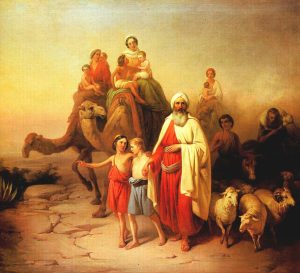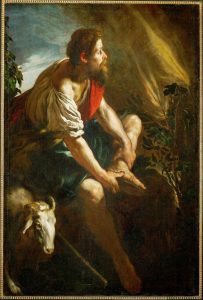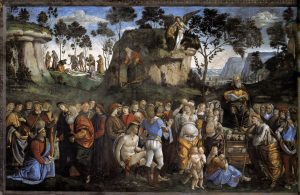2.5 The Journey of the Israelites
Numerous Mesopotamian peoples shared the abundance of the Fertile Crescent and took turns dominating the region. Most of them adopted the Sumerian writing system, cuneiform, and treasured the mythic tradition of Gilgamesh. Several shared Semitic cultural and linguistic roots: Akkadians, Assyrians, Arabs, and a people who migrated from the great city of Ur.
The Call of Abraham
The ethnic identity of the Jewish People[1] is rooted in the Call of Abram to strike out by faith, leaving “Ur of the Chaldeans[2] to go into the land of Canaan.”
Now the Lord said to Abram, “Go from your country and your kindred and your father’s house to the land that I will show you. And I will make of you a great nation, and I will bless you, and make your name great, so that you will be a blessing. I will bless those who bless you, and him who curses you I will curse; and by you all the families of the earth shall bless themselves.”
So Abram went, as the Lord had told him; and Lot went with him … and they set forth to go to the land of Canaan. … Then the Lord appeared to Abram, and said, “To your descendants I will give this land.” So he built there an altar to the Lord, who had appeared to him. Thence he removed to the mountain on the east of Bethel, and pitched his tent, with Bethel on the west and Ai on the east; and there he built an altar to the Lord and called on the name of the Lord Genesis 11.27-12.9).
 |
| József Molnár. (1850). Abraham’s Journey from Ur to Canaan. Oil on canvas. |
The Art of Israel
The mythic tradition of Gilgamesh was closely intertwined with a tradition in visual art: illustrated seals, figurines, and reliefs. So where do we find the sculpture and paintings that portrayed the Jewish people? Well, there wasn’t one. Hebrew religious laws strictly forbade its people to compose images:
When Abraham and his family left Ur, they left behind not only its lands but also its religious beliefs and practices. Nearly all ancient peoples acknowledged numerous deities. They believed that the gods actually lived in statues and Temples. Rites and rituals addressed the images as if directly worshipping the gods.
The God of Abraham was a single, all-powerful creator who instructed His people never to honor other people’s ideas of God or to make or to worship any God in the form of an image made by human hands.
Thus Jews were forbidden to represent human or animal figures in wood, stone, metal or other media. In other words, they were forbidden to create visual art. Jewish artistic aspirations were devoted to non-visual media: songs, verse, and storytelling. The Jewish artist was a writer or scribe. With their artistic energies focused on literature and scripture, the Jewish People have long been known as “the people of the book.”[3]
Jewish writing was composed, not on cuneiform tablets, but using a variant of the phonetic alphabet developed by their Semitic cousins, the Phoenicians. They treasured books that told their origin story and instructed them in the ways that they should live. Hebrew scriptures were organized in three divisions:
- Torah (Instruction): an account of God’s creativity and instructions for His people
- Nevi’im (Prophets): the teachings of God’s messengers
- Ketuvim (Writings): a varied collection of wise reflections
[1] Jewish People: the People of Israel—i.e. descendants of the Patriarch Israel—are variously referred to as Israelites, Hebrews, and Jews.
[2] Ur of the Chalde′ans : scholars and archaeologists debate which city is thus designated by the Hebrew text.
[3] When Islamic armies conquered Asia Minor, Palestine, northern Africa, and Spain in the 7th and 8th Centuries CE, Jews and Christians were afforded limited privileges as the “people of the book,” the Hebrew and Christian scriptures which inspired Muhammad and are honored by Muslims to this day.
The Call of Moses
Torah begins with the Creation Story, relates the Call of Abraham, and follows the people’s journey into slavery in Egypt. It continues with the Call of Moses to lead his people to freedom and issue God’s law.
Moses was keeping the flock of his father-in-law Jethro, the priest of Midian; he led his flock beyond the wilderness and came to Mount Horeb, the mountain of God. There the angel of the Lord appeared to him in a flame of fire out of a bush; he looked, and the bush was blazing, yet it was not consumed.
Then Moses said, “I must turn aside and look at this great sight and see why the bush is not burned up.”
When the Lord saw that he had turned aside to see, God called to him out of the bush, “Moses, Moses!”
And he said, “Here I am.”
Then he said, “Come no closer! Remove the sandals from your feet, for the place on which you are standing is holy ground.” He said further, “I am the God of your father, the God of Abraham, the God of Isaac, and the God of Jacob.” And Moses hid his face, for he was afraid to look at God.
Then the Lord said, “I have observed the misery of my people who are in Egypt; I have heard their cry on account of their taskmasters. Indeed, I know their sufferings, and I have come down to deliver them from the Egyptians and to bring them up out of that land to a good and spacious land, to a land flowing with milk and honey (Exodus 3.7-8).
 |
| Domenico Fetti. (1617). Moses and the Burning Bush. Oil on canvas. |
The Law on Sinai
On the morning of the third day there was thunder and lightning, as well as a thick cloud on the mountain and a blast of a trumpet so loud that all the people who were in the camp trembled. Moses brought the people out of the camp to meet God. They took their stand at the foot of the mountain. Now all of Mount Sinai was wrapped in smoke, because the Lord had descended upon it in fire; the smoke went up like the smoke of a kiln, while the whole mountain shook violently. As the blast of the trumpet grew louder and louder, Moses would speak and God would answer him in thunder. When the Lord descended upon Mount Sinai, to the top of the mountain, the Lord summoned Moses to the top of the mountain, and Moses went up (Exodus 20.16-20).
The Decalogue (Ten Commandments)
Then God spoke all these words, “I am the Lord your God, who brought you out of the land of Egypt, out of the house of slavery; you shall have no other gods before me.
- “You shall not make for yourself an idol, whether in the form of anything that is in heaven above or that is on the earth beneath or that is in the water under the earth. You shall not bow down to them or serve them, for I the Lord your God am a jealous God, punishing children for the iniquity of parents to the third and the fourth generation of those who reject me but showing steadfast love to the thousandth generation of those who love me and keep my commandments.
- “You shall not make wrongful use of the name of the Lord your God, for the Lord will not acquit anyone who misuses his name.
- “Remember the Sabbath day and keep it holy. Six days you shall labor and do all your work. But the seventh day is a Sabbath to the Lord your God; you shall not do any work—you, your son or your daughter, your male or female slave, your livestock, or the alien resident in your towns. For in six days the Lord made heaven and earth, the sea, and all that is in them, but rested the seventh day; therefore the Lord blessed the Sabbath day and consecrated it.
- “Honor your father and your mother, so that your days may be long in the land that the Lord your God is giving you.
- “You shall not murder.
- “You shall not commit adultery.
- “You shall not steal.
- “You shall not bear false witness against your neighbor.
- “You shall not covet your neighbor’s house; you shall not covet your neighbor’s wife, male or female slave, ox, donkey, or anything that belongs to your neighbor” (Exodus 20.1-17).
Sadly, when Moses returned to the people, he found them worshipping an idol. The result was a 40-year sojourn in “the wilderness” and God’s promise that Moses would never enter the Promised Land.
The Death of Moses
 |
| Luca Signorelli and Bartolomeo della Gatta. (c 1482). Testament and Death of Moses. Fresco. |
The Force of Story
Have you ever wondered why a collection of writings called “The Law” contains far more storytelling than legal principles? Clearly, Torah authors felt that the ethical and spiritual principles of their faith grew out of the story of their lived relationship with a God whom they encountered in powerful personal interactions.
And that, of course is the essence of the art of narrative. The long chronicle of early Jewish history gains force through artful storytelling. It displays elements of narrative that we will be exploring as we go along:
Narrative: a telling of story events through a medium: e.g. an author’s voice, a movie camera, etc.
Story: a connected series of events and actions that play out in a world projected by a narrative
Character: a participant in the actions and events of a story
Drama (in narrative): a driving narrative force in which conflicts raise suspense and lead to a powerful or spectacular climax
Torah abounds in powerful dramatic encounters between forceful personalities: Moses, Pharaoh, God. The burning bush. Thunder on the mountain. Far more memorable moments than we can sample here. This holy narrative powerfully dramatizes a people’s relationship to God and the conferring of divine law.
developed first for accounting, a Mesopotamian form of writing that incised marks on small clay tablets which developed into the world’s first known form of recorded literature
a mythic tale which provides a framework for comprehending the development of some aspect of the heavens, the world, or human ways of living. Often presented as the birth of a people.
